◯형 다리와 X형 다리, Bowlegs (Genu varum) and Knock knees(Genu valgus)

그림 90. 자궁 내 태아의 아랫다리가 위 그림과 같이 정상적으로 안으로 구부린 태위를 취하고 있다가 태어나는 것이 보통이다. 태어난 후부터 생후 0~18개월까지 아랫다리가 안으로 구부러져 있는 ◯형 다리를 갖는 것이 보통이다. 이런 다리를 생리적 ◯형 다리라고 한다.
Copyright ⓒ 2011 John Sangwon Lee, M.D., FAAP

사진 91. 출생 후 첫 몇 개월 동안 영아들은 태위를 취하면서 자는 것이 보통이다.
엎드려 자는 신생아의 두 다리가 ◯형 자세를 취하고 있다.
Copyright ⓒ 2011 John Sangwon Lee, M.D., FAAP
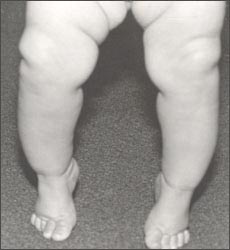
사진 94. 생리적 ○형 다리(생리적 내반슬)
Copyright ⓒ 2011 John Sangwon Lee, M.D., FAAP

사진 95. 생리적 ○형 다리(생리적 내반슬)가 좀 더 심하고 경골이 안으로 굽어져 무지내반이 생겨 있다.
Copyright ⓒ 2011 John Sangwon Lee, M.D., FAAP
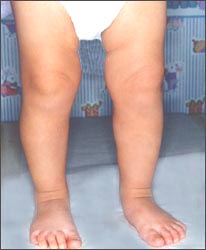
사진 97. 생리적 ○형 다리의 대부분이 생후 18~30개월경 생리적 X형 다리로 변화되는 것이 보통이다.
Copyright ⓒ 2011 John Sangwon Lee, M.D., FAAP
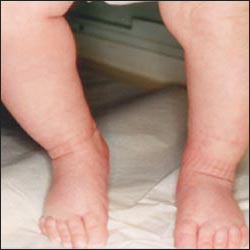
사진 96. 생리적 ○형 다리(생리적 내반슬)
Copyright ⓒ 2011 John Sangwon Lee, M.D., FAAP
- 두 발과 좌우 발목을 나란히 붙이고, 양쪽 두 다리를 평행되게 반듯이 쭉 뻗고 서 있을 때나 누워 있을 때 두 무릎 사이의 거리가 정상 이상으로 벌어져 있는 상태의 다리를 ○형 다리, ○각, 또는 내반슬이라 한다.
- 두 무릎을 평행되게 나란히 붙이고 양쪽 두 다리를 평행되게 반듯이 쭉 뻗고 서 있을 때나 누워 있을 때 두발목사이의 거리가 정상 이상으로 많이 벌어져 있는 상태의 다리를 X형 다리, X각, 또는 외반슬이라고 한다.
O형 다리와 X형 다리의 원인
- 대부분의 태아들은 자궁 속에서 그림 90과 사진 91과 비슷한 태위를 정상적(태아 생리적 외반슬)으로 취하고 있다가 태어난다.
- 태어나서부터 생후 18개월까지 대부분의 영유아들은 생리적 O형 다리를 계속 취한다., 거의 모든 갓 태어난 신생아들의 다리에 생리적 O형 다리가 나타나는 것이 보통이다. 생후 18개월경까지, 거의 모든 신생아들과 영유아들의 아랫다리는 정상적으로 약간 O형 다리이다. 이와 같이 질병이 없이 생긴 O형 다리를 ‘생리적 O형 다리’라고 한다.
- 대부분의 경우, 생리적 O형 다리는 신생아기 이후부터 생후 12~18개월경까지 계속되는 것이 보통이지만, 생후 12~18개월경 이후부터 유아들의 생리적 O형 다리의 대부분은 점차로 곧게 펴지기 시작하는 것이 정상 발육이다. 생리적 O형이었던 양쪽 아랫다리가 이제부터는 X형 다리 형태로 점점 변화되어 간다.
- 그래서 생후 12~18개월경 이후부터, 대부분의 유아들이 양쪽 무릎을 나란히 붙이고 곧게 쭉 뻗으면 양쪽 아랫다리가 약간 외번되기 시작하고 경미한 X형 다리 형태가 생기기 시작한다.
- 뚜렷한 병이 없이 이렇게 생긴 X형 다리를 ‘생리적 X형 다리’라고 한다.
- 이런 생리적 X형 다리(생리적 외반슬)는 생후 2~3세경까지 점차로 더 뚜렷하게 나타날 수 있다.
- 그 생리적 X형 다리는 5~6세경 다시 곧게 펴지기 시작해서 사춘기가 될 때쯤 두 아랫다리를 나란히 쭉 뻗을 때 두 무릎과 두 발목이 서로 거의 마주 닫는 것이 정상다리 발육과정이다.
- 그래서 6~7세 이후부터 사춘기 전까지 대부분의 학령기 아이들의 아래 두 다리는 약간 생리적 X형 다리 형태인 것이 보통이다. 그와 같은 형태의 다리를 성인이 되어서도 계속 갖는 것이 보통이다.
- 이와 같이 정상 성장 발육으로 생긴 생리적 X형 다리나 생리적 O형 다리는 정상적이고 아무 치료가 요하지 않는다.
- 사진 94~96의 생리적 O형 다리도 치료 없이 자연히 정상으로 되었다.
- 드물게,
-
- 다리에 생긴 외상,
- 선천성 질병,
- 골격 이형성증,
- 블라운트 병(Blount’s disease),
- 구루병,
- 어떤 종류의 신진대사 이상 등으로
- 비정상 O형 다리, 또는 비정상 X형 다리가 생길 수 있다.
- 그런 때는 원인에 따라서 적절히 치료 한다.

사진 98. 2세 유아의 정상 다리
Copyright ⓒ 2011 John Sangwon Lee, M.D., FAAP
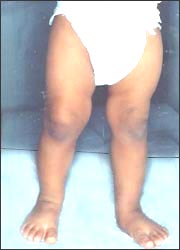
사진 99. 3세 유아의 정상 다리와 생리적 X형 다리(생리적 외반슬)
Copyright ⓒ 2011 John Sangwon Lee, M.D., FAAP

사진 100. 4세 유아의 생리적 X형 다리(생리적 외반슬)
Copyright ⓒ 2011 John Sangwon Lee, M.D., FAAP
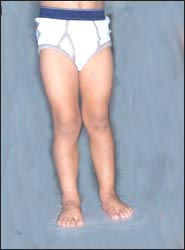
사진 101. 5세 유아의 생리적 X형 다리(생리적 외반슬)
Copyright ⓒ 2011 John Sangwon Lee, M.D., FAAP

사진102. 6세 학령기 아이의 정상 다리
Copyright ⓒ 2011 John Sangwon Lee, M.D., FAAP
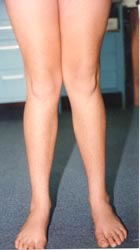
사진103. 7세 학령기 아이의 생리적 X형 다리(생리적 외반슬)
Copyright ⓒ 2011 John Sangwon Lee, M.D., FAAP
O형 다리와 X형 다리의 진단 치료
- 병력, 증상 징후, 진찰소견 등을 종합해서 진단한다.
- 대부분의 경미한 O형 다리나 X형 다리는 생리적으로 생기고 정상적이다.
- 걱정이 되면 정기 건강검진을 받을 때 의사에게 문의한다.
- 드물게 어떤 병으로 병적 O형 다리나 병적 X형 다리가 생길 수 있다.
- 어떤 병으로 비정상적으로 생긴 O형 다리나 X형 다리가 있으면 정형외과 전문의의 검진 진단을 받는다. 필요에 따라 다리 X선 사진 검사로 진단할 수 있다.
- 구루병, 신진대사 이상, 다리 외상, 선천성 질병, 골격 이형성증, 블라운트 병 등으로 생긴 병적 O형 다리나 병적 X형 다리는 생리적 O형 다리나 생리적 X형 다리와 감별 진단해야 한다.
- 만일 O형 다리가 생후 2세 이후 뚜렷하게 계속 지속되든지, 심하게 생겨 있든지, 한쪽 다리에만 O형 다리가 생겨 있든지, 키가 비정상적으로 아주 작거나 크든지, X형 다리가 6~7세 이후에도 심하게 계속되든지, X형 다리의 정도가 아주 심하면 원인을 알아서 치료해야 한다.
- 또한 X 형 다리가 한 쪽에만 생긴다든지, 친 부모 형제자매들 중 누군가가 비정상적으로 키가 작으면서 O형 다리나 X형 다리를 가지고 있을 때는 그 원인을 알아서 치료해야 한다.
|
다음은 “○형 다리와 X형 다리. 18개월 아기의 안짱걸음”에 관한 인터넷 소아청소년 건강상담 질의응답의 예 입니다. |
Q&A. ◯형 다리와 X형 다리. 18개월 아기의 안짱걸음
Q.
안녕하세요. 저는 18개월 된 아들과 두 달이 다 되어가는 딸이 있습니다.
그런데, 18개월 된 아들이 걸음을 안짱걸음을 합니다. 주위 분들이 걸음이 이상 하다고 병원을 가보도록 권유를 하는데, 남편은 괜찮다고 병원은 안 가도 된다고 합니다. 걸음을 안으로 뚜벅뚜벅 걷는데, 같은 또래의 아이들은 똑바로 걷는 것을 보았습니다. 걸음이 안으로 들어가다 보니 자주 넘어지기도 합니다. 이런 경우는 병원을 가야 하는지, 가지 않아도 된다면 집에서 치료는 어떻게 해야 하는지 가르쳐 주십시오. 그리고 둘째 딸은 이제 두 달이 되어 가는데, 변을 이틀에 삼일에 한 번씩 봅니다. 변은 황색이고 죽처럼 걸쭉합니다. 보통 아이들은 변을 하루에 한 번씩 보는 것으로 아는데, 이 경우도 변비인가요. 변비이면 치료는 어떻게 해야 하나요. 꼭 답변을 해주셨으면 감사 하겠습니다.
A.
김청님
안녕하세요. 좋은 질문해 주셔서 감사합니다.
자녀의 나이, 성별, 과거 병력, 가족 병력, 진찰소견, 임상검사 등의 정보를 많이 알수록 답변을 드리는데 도움이 됩니다. 주신 정보를 토대로 해서 답변을 드리겠습니다.
걷는 상태를 관찰해 보고 검진하고 무엇 때문에 안짱걸음을 걷는지 어느 정도 안짱걸음을 걷는지 알아보고 답변을 드리는 것이 당연합니다.
그러나 다음 정보를 참작하시면 좋을 것입니다.
출생 후 24시간 내에 한번, 신생아실에서 퇴원해서 집에 가기 전 한 번 더 신생아 건강검진을 받고 병원 신생아실에서 퇴원한 이후 생후 3~14일에 한 번 신생아 건강검진을 받고,
그 후 생후 1, 2, 4, 6, 9, 12, 15, 18개월에 소아청소년과에서 건강검진을 정기적으로 받는 것이 좋다고 미 소아과학회에서 권장합니다.
매번 정기 건강검진을 받을 때 몸에 어떤 이상이 있는지 머리끝에서 부터 발끝까지 신체검진을 받고,
그 동안 섭취했던 음식물의 종류와 양, 영양분 등이 나이에 적절히 섭취했었는지 알아보고, 필요한 기본 감염병 백신으로 예방 접종받고
안전사고 예방에 관해서 상담하고
나이에 따른 성장발육이 정상인지 비정상인지 알아보고
의사와 부모가 자녀 양육에 관해 서로 상담하는 것이 일반적입니다.
소아청소년과에서 건강검진을 받으시고 이런 문제들에 관해 상담하시기를 바랍니다.
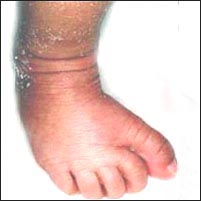
사진 104. 신생아의 발의 앞부분이 안쪽으로 구부러져서 생긴 생리적 내반족.
Copyright ⓒ 2011 John Sangwon Lee, M.D., FAAP
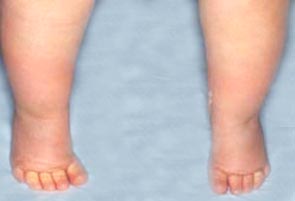
사진 105. 3개월 영아의 발의 앞부분이 안으로 구부러져서 생긴 생리적 내반족.
Copyright ⓒ 2011 John Sangwon Lee, M.D., FAAP
출생 후부터 생후 12~24개월경까지 대부분의 영유아들에게 생리적 O형 다리가 정상적으로 생깁니다. 그러나 O형 다리가 어떤 병으로도 생길 수 있습니다. 자녀의 의사로부터 정기 건강검진을 받고 다리에 생리적 O형 다리가 있는지 아니면 비정상적인 병적 O형 다리가 있는지 알아보시고 병적 O형 다리가 있다면 단골 소아청소년과 의사의 소개를 받아 정형외과 전문의에게 자문을 받는 것이 좋을 것 같습니다.
어떤 병은 적기에 적절히 치료하지 않으면 일생 동안 장애자가 될 수 있습니다.
무엇 때문에 안짱걸음을 걷는지 모르고 있는 상태에서 그냥 관찰적 치료만 하고 있는 것은 적절치 않은 치료입니다.
2~3개월 된 영아들 중 모유나 인공영양을 매번 먹은 후 대변을 보기도 합니다. 때로는 3~4일 만에 대변을 걸쭉하게 보는 영아들도 있습니다.
이것은 변비가 아니고 정상입니다.
걱정하실 것이 없습니다.
[부모도 반의사가 되어야 한다–소아가정간호백과]-제 2권 소아청소년 질병, 안전사고 예방–정기 건강검진, 제 3권 제 3권 신생아, 영유아, 학령기 아이 사춘기 아이 성장발육–해당 연령의 성장 발육, 제 9권 소아청소년 소화기 질환–정상 대변, O형 다리와 X형 다리 등을 참조하시기 바랍니다.
필요에 따라 소아청소년과에서 진찰 진단 치료를 받고 상담하시기 바랍니다. 질문이 더 있으시면 다시 연락 주세요. 감사합니다.
◯ and X-legs, Bowlegs (Genu varum) and Knock knees(Genu valgus)

Figure 90. In the womb, it is common for the lower leg of the fetus to take a normal inward-bent position as shown in the figure above before being born. From birth to 0-18 months of age, it is common to have an ◯ leg with the lower leg bent inward. These legs are called physiological ◯ legs. Copyright ⓒ 2011 John Sangwon Lee, M.D., FAAP

Picture 91. In the first few months after birth, it is normal for infants to sleep in a gestational position. The two legs of a newborn baby sleeping on their stomach are in the ◯ position. Copyright ⓒ 2011 John Sangwon Lee, M.D., FAAP

Photo 94. Physiological type ○ leg (physiological varus knee) Copyright ⓒ 2011 John Sangwon Lee, M.D., FAAP

Photo 95. Physiological type ○ The leg (physiological varus) is more severe and the tibia is bent inward, resulting in a varus varus. Copyright ⓒ 2011 John Sangwon Lee, M.D., FAAP

Photo 97. Physiological ○ Most of the legs are usually changed to physiological X-shaped legs around 18-30 months of age. Copyright ⓒ 2011 John Sangwon Lee, M.D., FAAP

Photo 96. Physiological type ○ leg (physiological varus knee) Copyright ⓒ 2011 John Sangwon Lee, M.D., FAAP
• Put your feet and left and right ankles side by side, and stretch both legs in parallel to each other. When you stand or lie down, the distance between your knees is wider than normal. do.
• Legs with both knees parallel to each other, with both legs straight and straight, when standing or lying down, the distance between the ankles is more than normal.
Causes of Type O Legs and Type X Legs
• Most fetuses are born in the womb with a normal (fetal physiological valgus) position similar to those in Figures 90 and 91.
• From birth to 18 months of age, most infants and toddlers continue to adopt physiological O-legs. It is common for almost all newborns to have physiological O-legs on their legs. By 18 months of age, the lower legs of almost all newborns and infants are normally slightly O-legged. This type of O-leg without disease is called ‘physiological O-leg’.
• In most cases, physiological O-legs usually continue from newborn to around 12 to 18 months of age, but from around 12 to 18 months of age, most of the physiological O-legs in infants begin to straighten gradually. normal development. Both lower legs, which were physiological O-type, are gradually changing into X-type legs from now on.
• So, from around 12 to 18 months of age, when most infants put their knees together and stretch them out straight, both lower legs begin to rotate slightly and a slight X-leg shape begins to form.
• X-shaped legs that look like this without any obvious disease are called ‘physiological X-shaped legs’.
• These physiological X-shaped legs (physiological valgus) may gradually become more pronounced until around 2-3 years of age.
• The physiological X-shaped leg begins to straighten again around the age of 5 or 6, and when the two lower legs are stretched out side by side around the time of puberty, the normal leg development process is that the knees and ankles almost close each other.
• So, from age 6-7 until puberty, it is common for most school-age children to have a slightly physiological X-legged lower leg. It is normal to continue to have those same types of legs into adulthood.
• Physiological X-type legs or physiological O-type legs resulting from normal growth and development are normal and do not require any treatment.
• Physiological type O legs in pictures 94~96 also returned to normal without treatment.
• Rarely,
• o Trauma to the leg;
o congenital diseases;
o skeletal dysplasia,
o Blount’s disease,
o Rickets,
o Metabolic abnormalities of any kind, etc.
o Abnormal O-legs or abnormal X-legs may develop.
• In such a case, appropriate treatment according to the cause.

Photo 98. Normal legs of a 2-year-old infant Copyright ⓒ 2011 John Sangwon Lee, M.D., FAAP

Photo 99. Normal leg and physiological type X leg (physiological valgus) of a 3-year-old infant Copyright ⓒ 2011 John Sangwon Lee, M.D., FAAP

Photo 100. Physiological type X leg of a 4-year-old infant (physiological valgus) Copyright ⓒ 2011 John Sangwon Lee, M.D., FAAP

Photo 101. Physiological type X leg of a 5-year-old infant (physiological valgus) Copyright ⓒ 2011 John Sangwon Lee, M.D., FAAP

Picture 102. Normal legs of a 6-year-old school-age child Copyright ⓒ 2011 John Sangwon Lee, M.D., FAAP

Picture 103. Physiological type X leg (physiological valgus) in a 7-year-old school-age child Copyright ⓒ 2011 John Sangwon Lee, M.D., FAAP
Diagnosis Treatment of Type O Legs and Type X Legs
• Diagnosis is made by combining medical history, symptoms, and examination findings.
• Most mild O-legs or X-legs are physiologically occurring and normal.
• If you are concerned, ask your doctor at your regular health check-up.
• Rarely, a disease can cause pathologic type O legs or pathologic type X legs.
• If you have an abnormally shaped O-leg or X-shaped leg due to some disease, see an orthopedic surgeon for diagnosis. If necessary, it can be diagnosed with a leg X-ray examination.
• Pathological type O leg or pathologic type X leg caused by rickets, metabolic abnormality, leg trauma, congenital disease, skeletal dysplasia, Blount’s disease, etc. should be differentiated from physiological type O leg or physiological type X leg.
• If the type O leg remains distinctly persistent or severe after 2 years of age, if the type O leg develops on only one leg, whether the leg is abnormally short or very tall, or if the type X leg continues after 6 or 7 years of age, If it continues to be severe or the degree of type X leg is very severe, the cause must be identified and treated.
• Also, if the type X leg occurs only on one side, or if one of your biological parents or siblings is abnormally short and has an O-leg or an X-leg, the cause should be identified and treated. Next is “Type ○ legs and X-shaped legs.
This is an example of a Q&A on health counseling for children and adolescents on the Internet about “an 18-month-old baby.”
Q&A. ◯-shaped legs and X-shaped legs. 18 month old baby Q.
Hello. I have an 18 month old son and a 2 month old daughter. However, my 18-month-old son walks erratically.
People around me recommend that I go to the hospital because my gait is strange, but my husband says it’s okay, so I don’t have to go to the hospital. As I trudged inward, I saw children of the same age walking straight. As I step inside, I often fall. In this case, please tell me if I should go to the hospital and if I don’t have to go, how to treat at home. And my second daughter, now two months old, has a bowel movement every three days. The stool is yellow and thick like porridge. Usually children know that they have a bowel movement once a day, but is this also constipation?
If you are constipated, how should you treat it? Thank you for your reply. A. Kim Cheong-nim Hello. Thanks for the nice question. The more information you know about your child’s age, gender, past medical history, family history, examination findings, and clinical tests, the more helpful it is to give you an answer.
We will give you an answer based on the information you provided. It is natural to observe the walking condition, check it, find out why and to what extent it walks awkwardly and give an answer.
However, you may want to consider the following information. Once within 24 hours after birth, one more time before going home after being discharged from the neonatal unit, and once every 3 to 14 days after being discharged from the hospital neonatal unit. After that, at 1, 2, 4, 6, 9, 12, 15, and 18 months after birth, it is recommended by the American Academy of Pediatrics to have regular health checkups at the Department of Pediatrics.
Every time you receive a regular health checkup, you receive a physical checkup from head to toe to see if there are any abnormalities in your body. Find out if the type, amount, and nutrients of the food you have eaten are adequate for your age, and get vaccinated with the necessary basic infectious disease vaccine.
Consultation on safety accident prevention Find out if growth and development according to age are normal or abnormal It is common for doctors and parents to talk to each other about raising children. Please have a health check-up at the Department of Pediatrics and discuss these issues.

Picture 104. Physiological varus foot caused by an inward flexion of the anterior part of the foot of a newborn baby. Copyright ⓒ 2011 John Sangwon Lee, M.D., FAAP

Picture 105.Physiological varus of a 3-month-old infant caused by an inward flexion of the anterior part of the foot. Copyright ⓒ 2011 John Sangwon Lee, M.D., FAAP
From birth to around 12 to 24 months of age, most infants and toddlers develop physiological O-legs normally. However, type O legs can result from any disease. It is a good idea to get regular health checkups from your child’s doctor, find out whether the legs have a physiological type O leg or an abnormal pathological type O leg.
It seems good. Some ailments can be lifelong if not properly treated at the right time. It is inappropriate treatment to simply perform observational treatment without knowing why the person is walking without knowing why. Some 2-3 month old infants have a bowel movement after each feeding of breast milk or artificial nutrition.
Sometimes infants have thick stools after 3 or 4 days.
This is not constipation and is normal. Nothing to worry about.www.drleepediatrics.com- Volume 2 Prevention of diseases and safety accidents in children and adolescents – Periodic health checkups, Volume 3 Volume 3 Newborns, infants, and school-age children Please refer to Development, Volume 9 Gastrointestinal Disorders in Children and Adolescents-Normal Stool, Type O Legs and Type X Legs, etc.
If necessary, please consult with the Department of Pediatrics for diagnosis, diagnosis and treatment. If you have any more questions, please contact us again. thank you.
출처 및 참조 문헌 Sources and references
- NelsonTextbook of Pediatrics 22ND Ed
- The Harriet Lane Handbook 22ND Ed
- Growth and development of the children
- Red Book 32nd Ed 2021-2024
- Neonatal Resuscitation, American Academy Pediatrics
- www.drleepediatrics.com 제1권 소아청소년 응급 의료
- www.drleepediatrics.com 제2권 소아청소년 예방
- www.drleepediatrics.com 제3권 소아청소년 성장 발육 육아
- www.drleepediatrics.com 제4권 모유,모유수유, 이유
- www.drleepediatrics.com 제5권 인공영양, 우유, 이유식, 비타민, 미네랄, 단백질, 탄수화물, 지방
- www.drleepediatrics.com 제6권 신생아 성장 발육 육아 질병
- www.drleepediatrics.com제7권 소아청소년 감염병
- www.drleepediatrics.com제8권 소아청소년 호흡기 질환
- www.drleepediatrics.com제9권 소아청소년 소화기 질환
- www.drleepediatrics.com제10권. 소아청소년 신장 비뇨 생식기 질환
- www.drleepediatrics.com제11권. 소아청소년 심장 혈관계 질환
- www.drleepediatrics.com제12권. 소아청소년 신경 정신 질환, 행동 수면 문제
- www.drleepediatrics.com제13권. 소아청소년 혈액, 림프, 종양 질환
- www.drleepediatrics.com제14권. 소아청소년 내분비, 유전, 염색체, 대사, 희귀병
- www.drleepediatrics.com제15권. 소아청소년 알레르기, 자가 면역질환
- www.drleepediatrics.com제16권. 소아청소년 정형외과 질환
- www.drleepediatrics.com제17권. 소아청소년 피부 질환
- www.drleepediatrics.com제18권. 소아청소년 이비인후(귀 코 인두 후두) 질환
- www.drleepediatrics.com제19권. 소아청소년 안과 (눈)질환
- www.drleepediatrics.com 제20권 소아청소년 이 (치아)질환
- www.drleepediatrics.com 제21권 소아청소년 가정 학교 간호
- www.drleepediatrics.com 제22권 아들 딸 이렇게 사랑해 키우세요
- www.drleepediatrics.com 제23권 사춘기 아이들의 성장 발육 질병
- www.drleepediatrics.com 제24권 소아청소년 성교육
- www.drleepediatrics.com 제25권 임신, 분만, 출산, 신생아 돌보기
- Red book 29th-31st edition 2021
- Nelson Text Book of Pediatrics 19th- 21st Edition
- The Johns Hopkins Hospital, The Harriet Lane Handbook, 22nd edition
- 응급환자관리 정담미디어
- Pediatric Nutritional Handbook American Academy of Pediatrics
- 소아가정간호백과–부모도 반의사가 되어야 한다, 이상원 저
- The pregnancy Bible. By Joan stone, MD. Keith Eddleman, MD
- Neonatology Jeffrey J. Pomerance, C. Joan Richardson
- Preparation for Birth. Beverly Savage and Dianna Smith
- 임신에서 신생아 돌보기까지. 이상원
- Breastfeeding. by Ruth Lawrence and Robert Lawrence
- Sources and references on Growth, Development, Cares, and Diseases of Newborn Infants
- Emergency Medical Service for Children, By Ross Lab. May 1989. p.10
- Emergency care, Harvey Grant and Robert Murray
- Emergency Care Transportation of Sick and Injured American Academy of Orthopaedic Surgeons
- Emergency Pediatrics A Guide to Ambulatory Care, Roger M. Barkin, Peter Rosen
- Quick Reference To Pediatric Emergencies, Delmer J. Pascoe, M.D., Moses Grossman, M.D. with 26 contributors
- Neonatal resuscitation Ameican academy of pediatrics
- Pediatric Nutritional Handbook American Academy of Pediatrics
- Pediatric Resuscitation Pediatric Clinics of North America, Stephen M. Schexnayder, M.D.
-
Pediatric Critical Care, Pediatric Clinics of North America, James P. Orlowski, M.D.
-
Preparation for Birth. Beverly Savage and Dianna Smith
-
Infectious disease of children, Saul Krugman, Samuel L Katz, Ann A.
- 제4권 모유, 모유수유, 이유 참조문헌 및 출처
- 제5권 인공영양, 우유, 이유, 비타민, 단백질, 지방 탄수 화물 참조문헌 및 출처
- 제6권 신생아 성장발육 양호 질병 참조문헌 및 출처
- 소아과학 대한교과서
Copyright ⓒ 2014 John Sangwon Lee, MD., FAAP
“부모도 반의사가 되어야 한다”-내용은 여러분들의 의사로부터 얻은 정보와 진료를 대신할 수 없습니다.
“The information contained in this publication should not be used as a substitute for the medical care and advice of your doctor. There may be variations in treatment that your doctor may recommend based on individual facts and circumstances.
“Parental education is the best medicine.